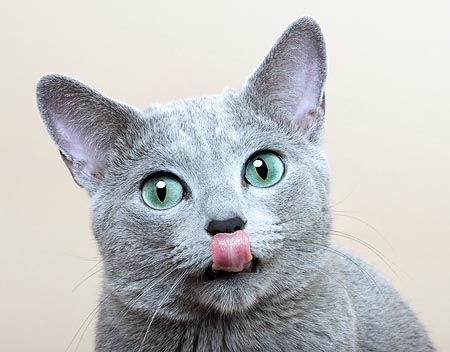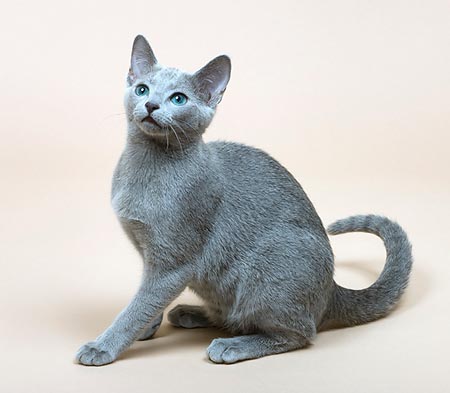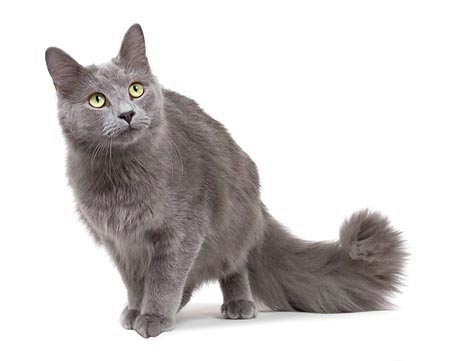Family : Felidae

Text © Dr Didier Hallépée

English translation by Mario Beltramini

Bright intelligence, silver blue mantle and green eyes © Giuseppe Mazza
The Russian cat is also known under the name of Russian Blue, Arkhangelsk Blue or Maltese Cat.
The first known specimens in England have reached Great Britain coming from Arkhangelsk, Russia, from where the names of Arkhangelsk Cat, Archangel, Archangel Blue they got by that time. Some of them were exposed at the first feline exposition at Crystal Palace in 1871, in a class reserved to the blue cats. From this exposition they could see long hair specimens.
After some theories, this cat should be native to the Mediterranean Basin, like the Chartreux. From there, it should have gone eastwards to Russia where it was appreciated as companion animal and hunted for its warm fur, and westwards to Malta and Spain, what has earned it the name of Maltese cat or Blue Spanish. It is anyway under the name of Maltese cat that it has appeared in France in 1925. The breed got the name of Russian Blue in 1939.
With the Second World War, the breeding of the Russian Cat disappeared almost completely from Europe. On its side, the long haired variety was almost forgotten. The breeding of the Russian Blue appeared again in the sixties, when some crossings with the Siamese were tried before that these were forbidden in 1965 and that the breed did stabilize. It is also during the sixties that the breed became popular in USA. In 1984, in USA, Sarah Cobb recreated the long hairs variety of Russian Blue which got the name of Nebelung (creator of mist). Exchanges with Russia permitted to enrich the genetic pool. Furthermore, it happened then that the very rare Russian Blues were carriers of the recessive gene responsible for the semi-long hair, and this was also a precious contribution.
Finally, the lovers of the unexpected were able to get recognized the black Russian blue and the white one. Along this way, the breed was renamed Russian, being the name Russian Blue reserved to the blue specimens.
Character
The Russian Blue is characterized by its thick and fluffy mantle of a silver blue colour and by its green eyes. The Russian Blue has a bright intelligence, is very affectionate, playful, calm and discreet with a sweet and melodious meowing. It is very affectionate to its master with whom it can live a true love story. It is a charming companion, careful and sociable with other animals, often shy with strangers.

Russian Blue © Giuseppe Mazza
It is a timid cat which loves comfort and tranquillity and needs a calm and serene habitat. It needs, therefore, to be reassured when at an exposition.
It is a playful cat, active when it wishes to be so, never restless. The male cares its kittens and at times takes the place of the mother in surveying them.
Standard
The shape of the head is formed by seven plain faces as follows: from above the skull to the front; from this up to the tip of the nose, which, if seen in profile, forms a straight line; from the tip of the nose up to the extremity of the chin; two symmetrical faces on each side of the muzzle; two symmetrical ones formed by the broad and high cheek-bones. Triangular when seen from the front, the head is particularly wide at the level of the eyes. With its rounded outline, on the other hand, the rather short and without pinch muzzle prolongs the triangle of the head. The slightly raised corners of the mouth give a sweet, smiling-like expression.
Nut-shaped, the eyes are rather big and well spaced. In the adults, the colour is of the most possible intense green. As high as wide at the base, the ears are spaced of the width of one ear. Externally covered by short and thin hairs, they are furnished by longer hairs on the half of the internal surface. The neckline, long and thin, looks heavier than what really is due to the thickness of the fur.
The body, of foreign format, is long and elegant. Well muscled and without any heaviness, it may seem more robust than what in reality is due to the thickness of the fur, especially in the Nebelung. The bone-frame is thin and the musculature powerful. Long and thin, the paws are proportioned to the body. The feet are small and somewhat round.
Rather thick at the base, the tail is of average length, reaching the base of the scapulae. In the Russian, the tail gets thinner up to its sharp extremity. In the Nebelung, the tail is well furnished.
In the Russian, the mantle is short, thin and gentle due to the importance of its down-hair. In the Nebelung: the fur is of average length, formed by a rather thin down-hair covered by thicker guard hairs. Males often do have a nice collaret, more discreet in the females. Culottes are desirable as well as light lynx tips on the back of the ears.

Nebelung © Giuseppe Mazza
Authorized crossings
Russian x Russian – Russian (only blue) x Nebelung – Nebelung x Nebelung
Coat
Russian: Blue, black, white
Nebelung: Blue
Blue: Mantle of a uniform and bright blue, with a preference for the light tonalities. The extremity of the guard hairs has a silvery colouration giving the fur a bright look, like if sprinkled with silver. The truffle is coal-grey and the pads are dark lilac.
White: White mantle with silvery reflexes. The truffle and pads are pink.
Black: Brilliant coal black mantle up to the root. The truffle and pads are black or dark brown.
→ For general notions about Felidae please click here.
→ To appreciate the biodiversity within the CAT BREEDS please click here.
